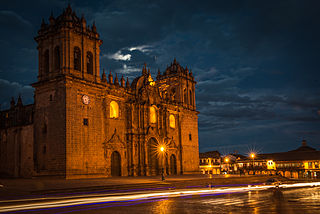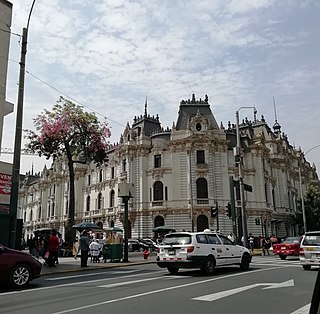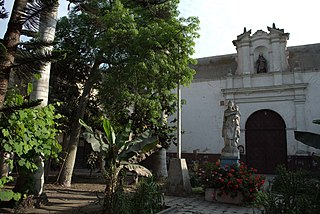
The Plaza Francia, also known by its former name, Plazoleta de la Recoleta, is a public square in the historic centre of Lima, Peru.

The Plaza Francia, also known by its former name, Plazoleta de la Recoleta, is a public square in the historic centre of Lima, Peru.
The square, originally named after the monastery of the Dominican Order built there in 1606, was the site of a pre-Hispanic trail that continued the path of the Camino de los Llanos (later known as the Vía Expresa ). In addition to its current church, it also housed another chapel, known as the Capilla de la Virgen de la Leche. [1]
After independence, the Convent of the Venturous Mary Magdalene (Spanish : Convento de la Venturosa María Magdalena) became administered by the Charity of Lima. In 1848, nuns from the Congregation of the Sacred Hearts of Jesus and Mary arrived to Peru and established themselves on the convent. [1] In 1881, the church burnt down, and, after the War of the Pacific, it was rebuilt under a different name, with two schools that would be run by the congregation also being built. The Pontifical Catholic University of Peru was later inaugurated there. [1]
A hospice also operated on the plaza, founded by Bartolomé Manrique. He was stabbed to death in 1866, in the Ánimas de San Agustín street. [2]
The square received its current name after the French colony in Lima donated a statue to commemorate the Centennial of the Independence of Peru. [1] [3]

Recoleta is a barrio or neighborhood of Buenos Aires, Argentina, located in the northern part of the city, by the Río de la Plata. The area is perhaps best known to be the home of the distinguished Recoleta Cemetery. It is a traditional upper-class and conservative neighborhood with some of the priciest real estate in the city, known for Paris-style townhouses, lavish former palaces and posh boutiques.

Located principally in the city centre or Cercado de Lima and Rímac areas, the Historic Centre of Lima is among the most important tourist destinations in Peru.
Francisco Miró Quesada Cantuarias was a Peruvian philosopher, journalist and politician.

Christianity is the most widely professed religion in Peru, with Catholicism being its largest denomination.

The Jirón de la Unión, or Union Street, is a pedestrian street located in the Historic Centre of Lima, part of the capital of Peru. For many decades it was the most important boulevards of the city, often described as the most aristocratic, where many of the most affluent citizens of the city and most powerful men around the world would meet. Subsequently, with the deterioration of the center of Lima, the Jirón de la Unión lost its aristocratic character and became completely commercialized.

The Plaza Mayor de Lima, or Plaza de Armas de Lima, is considered one of the birthplaces of the city of Lima, as well as the core of the city. Located in the Historic Centre of Lima, it is surrounded by the Government Palace, Lima Metropolitan Cathedral, Archbishop's Palace of Lima, the Municipal Palace, and the Palacio de la Unión.

The Plaza Bolognesi is a roundabout located in the Lima District and the Breña District, in the capital of Peru. It is located at the intersection of Brazil Avenue, Arica Avenue, Alfonso Ugarte Avenue, Guzmán Blanco Avenue, and 9 December Avenue.

The National Club is a private club and civil association based in the Plaza San Martín of the Historic Centre of Lima. Founded on October 19, 1855, it has been the meeting place for the Peruvian aristocracy throughout the 19th and 20th centuries, as its members are members of the most distinguished and wealthy families in the country.

The Plaza Manco Cápac, formerly the Plaza Leguía, is a public square in Lima. Formerly named after president Augusto B. Leguía, its current name comes from Manco Cápac, the first Sapa Inca of Cuzco.

The Monument to Manco Cápac is a statue located in the homonymous square in La Victoria District, Lima, the work of the Peruvian sculptor David Lozano, inaugurated in 1926.

The Statue of Liberty is a bronze sculpture located in the Plaza Francia of the historic centre of Lima, Peru. It was made in 1926 according to the design of the French sculptor René Bertrand-Boutée and cast by Eugène Soleau. It is a one-piece bronze sculpture about 2 metres high and represents a standing female figure, dressed in a light tunic and with a laurel wreath on her head. This is installed on a 4.30 m high pedestal. The sculpture and the Plaza Francia were declared a monumental urban environment in 1972. In 2018, La Libertad was declared Cultural Heritage of the Nation.

The Flag Square is a public square in Lima, Peru. It is located next to the Mateo Salado Huaca at the intersection of Breña, Lima and Pueblo Libre districts.

The Church of the Sacred Hearts of Jesus and Mary, also known as the Iglesia de la Recoleta, is a Catholic church in the Plaza Francia in the historic centre of Lima, Peru. It was declared Cultural heritage of Peru in 2001.

Ramón Castilla Square, formerly known as Union Square, is a public square in the historic centre of Lima, Peru. It is one of three squares through which Alfonso Ugarte Avenue passes—the others being Dos de Mayo and Bolognesi—and is also located at the intersection of Argentina and Emancipación avenues. It is named after former president Ramón Castilla.

The Church and Convent of the Good Death, also known as the Church of Saint Camillus, after the order's founder, is a Catholic church and convent in the colonial area of the neighbourhood of Barrios Altos in Lima, Peru. The current temple was built at the end of the 19th century and is dedicated to Our Lady of the Good Death. It is located at the crossroads of the Áncash and Paruro streets, and is diagonal to the Trinitarian Church of Lima.

The Royal Hospital of Saint Andrew, originally known as the Hospital of Our Lady of the Conception, was a hospital in the neighbourhood of Barrios Altos, part of the historic centre of Lima, Peru.

Jirón Camaná is a major street in the Damero de Pizarro, located in the historic centre of Lima, Peru. The street starts at the Alameda Chabuca Granda and continues southwest until it reaches Jirón Jacinto López, next to the Plaza Francia, continuing directly south until it reaches Bolivia Avenue, next to the Lima Civic Center.

Uruguay Avenue is an avenue of the historic centre of Lima, Peru. It begins at its intersection with the Jirón de la Unión and continues until it reaches Alfonso Ugarte Avenue, where its path is continued by Venezuela Avenue, which crosses the entirety of the city until it reaches Callao.

The Ignacio Merino Municipal Pinacotheca, also known as the Pinacotheca of Lima, is a pinacotheca located at the Plaza Francia, part of the historic centre of Lima, Peru.